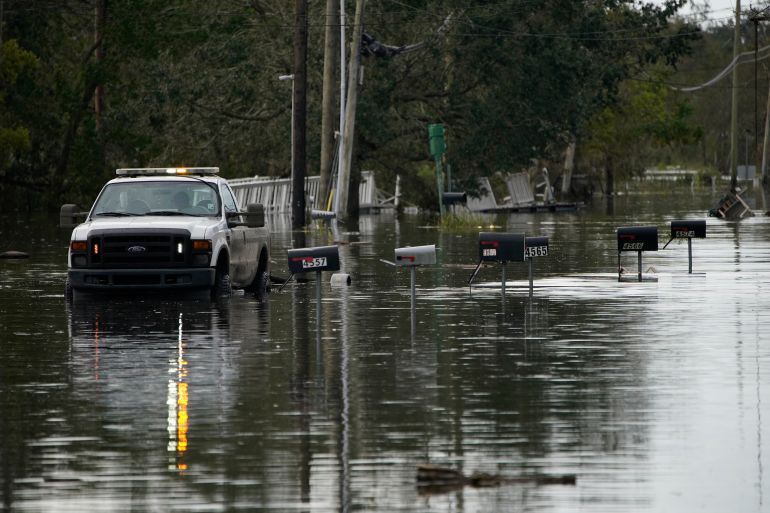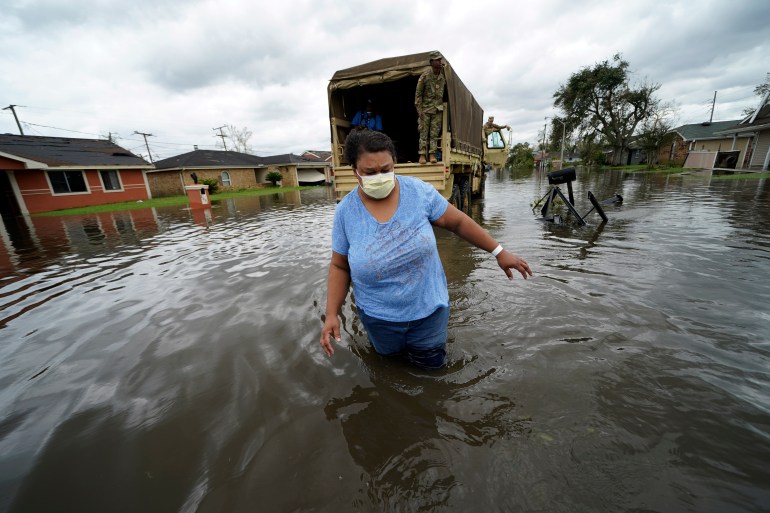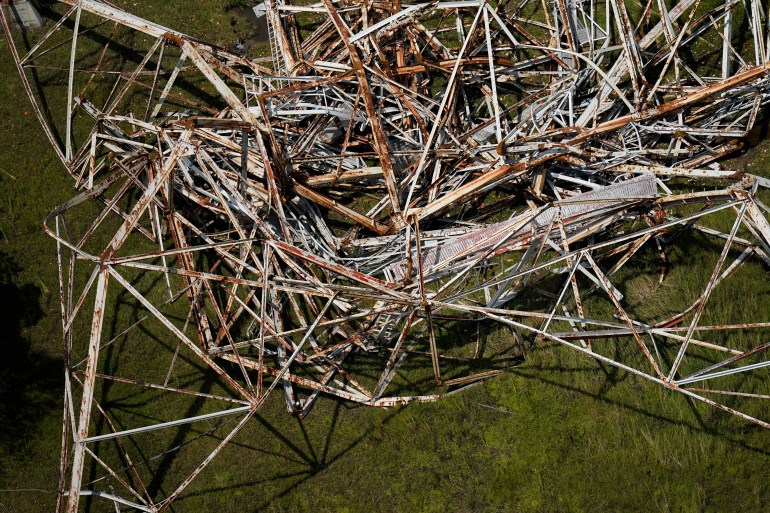Insurance crisis leaves homeowners vulnerable in hurricane-prone Louisiana
Since the 2020 hurricanes, nine insurers became insolvent in the US state of Louisiana within a couple of years.

After Charles Barnette and his wife bought their home in 2015 in LaPlace, Louisiana, United States, neighbours warned of devastating floods from past hurricanes. But Barnette never imagined how bad it could be.
In 2021, Category 4 Hurricane Ida hit Louisiana with a huge storm surge and extreme winds, causing an estimated $18bn in insured losses.
Keep reading
list of 4 itemsWhat’s troubling Brazil-Israel ties? Unpacking a love-hate relationship
US lawyers urge UK court to block Julian Assange extradition appeal bid
US tells ICJ Israel should not be ordered to immediately end occupation
The storm knocked an oak tree onto Barnette’s roof and flooded the home with up to 60cm (2 ft) of water. The water ruined the floors, walls, doors, cabinets, bedding, furniture, personal items, appliances and clothing. He had to hire a crane to remove the tree.
The couple received a small payment from the Federal Emergency Management Agency (FEMA) and their insurance company, Liberty Mutual, covered the cost of roof damage and removing the tree. But it refused to cover the water damage because it argued the policy did not include storm surge.
Barnette felt “screwed over” by the insurance company. “I believe that they are responsible because storm surge is wind-driven water and they are responsible for wind-driven damage,” he said in an email to Al Jazeera.
Following Hurricane Ida, he said his insurance rate began to slowly creep up to double what it was previously. “I feel the insurance company raised rates because of the area being prone to hurricanes.” (Liberty Mutual said it does not comment on individual policies and did not answer questions about how hurricanes have affected rates.)
“We have not changed providers because either companies will not cover us, have completely left the state, or their rates are higher than what we currently pay,” Barnette wrote.
Insurance companies are backing out of high-risk hurricane zones in the US, or becoming insolvent, leaving homeowners with few options. Many homeowners have seen their insurance costs increase or have been forced to buy expensive policies from state “insurers of last resort”. Due to the high costs, many homeowners are under-insured or uninsured.
Experts say the underlying problem is that people are living in vulnerable areas or in homes not fortified for future storms, and the insurance is not adequate to cover homeowners. Climate change is worsening the problem by sending more extreme hurricanes into the equation. Scientists warn that as the oceans grow warmer, more hurricanes will reach Category 3 or higher in the future.
The impact will not be evenly distributed. Research published in 2023 by the McKinsey Institute for Black Economic Mobility found that increased risk from hurricanes in the southeastern US states will disproportionately affect homes owned by African Americans.
Risky business models
“We built way too many houses in really dangerous places,” said Edward Richards, an emeritus professor at Louisiana State University who focuses on insurance and extreme weather.
Climate change is driving more powerful hurricanes but Richards said even without climate change, Louisiana already faces an intractable insurance problem.
“This is a bad land use problem, this is a bad insurance policy problem that would exist without climate change and climate change is going to make it worse,” he explained.

The policy problem began in 2005, when Hurricane Katrina hit Louisiana, causing damage estimated at $125bn. The following month, Hurricane Rita hit the state, bringing a storm surge that added to the damage of Katrina.
In 2005, State Farm and Allstate had the largest market share of homeowners’ business in Louisiana, according to outgoing insurance commissioner Jim Donelon, who spoke to Al Jazeera in December, his last month in office.
“This is not the state you want to have your largest market share in, for obvious reasons,” Donelon said.
After those hurricanes, State Farm and Allstate were concerned about their exposure and began to slowly reduce their market share in Louisiana by raising their hurricane deductibles, Donelon said. As the big companies withdrew from the state, smaller regional companies replaced them.
Then, 2020 and 2021 brought more huge storms to Louisiana – Hurricane Laura in 2020, and Hurricane Ida in 2021.
These two storms were followed by insurance companies collapsing one after the other. Since the 2020 storms, nine insurers became insolvent within a couple of years.
Donelon said that resulted in homeowners having to get coverage from the state’s insurer of last resort, Louisiana Citizens, which is state-mandated to be more costly than other insurance companies. “Well, it doubled in size between 2020 and 2021, from 65,000 policies to 130,000,” Donelon said.
A January investigation by the Baton Rouge Advocate and the Times-Picayune found that Louisiana’s home insurance market fell apart after the state moved insurance policies to small, regional companies with risky business models. The investigation found that nearly all the insurance companies that failed had paid affiliates to underwrite and handle claims. The affiliates faced less scrutiny from regulators than the insurance companies, the investigation revealed.
“Focusing on the Gulf Coast, we’re already in a hole,” Richards said of the insurance crisis. “If we could freeze climate change, we’d still have an insoluble problem.”
Future risks
In 2023, natural catastrophe losses in the US reached $80bn. That included $40bn in insured losses in the first half of the year, largely due to record severe storms, Hilary Segura, the assistant vice president of state government relations and counsel for the American Property Casualty Insurance Association, told Al Jazeera.

“There are several factors that are increasing the challenges that homeowners face regarding the affordability and availability of insurance nationwide, including record inflation and the significant increase in costly natural disasters,” Segura wrote in an email.
Segura said the property insurance market in Louisiana remains “extremely challenging”.
Donelon painted a bleak picture of the insurance crisis in his state. “It looks painfully similar to what we experienced after Katrina and Rita in 2005,” he said.
Many people remain at risk in Louisiana, he added, especially low-income households that tend to be uninsured or underinsured. Homes that are built to lower standards, or that are not fortified, are also at greater risk.
He foresees potential risk as the LNG (Liquified Natural Gas) industry continues to grow along the coast.
New LNG facilities bring jobs, meaning more demand for home construction in low-lying coastal areas. Those communities, he said, will need to build homes to higher standards to withstand 241km/h (150 mph) winds and larger storm surges.
Donelon is hopeful about new policies the state has introduced. Louisiana has copied a grant programme from Alabama that incentivises homeowners to fortify their roofs, lowering their insurance costs and adding value to their homes.
But three years after Hurricane Ida, Barnette’s home has still not been restored.
An unreliable contractor left him to do his own restoration construction on top of working a full-time job.
“Our house still isn’t complete. I’m having to do the work myself,” Barnette said.
He has a new roof but says it is too expensive to elevate the house to protect it from storm surges and flooding. Hurricane season officially begins on June 1, with some forecasters projecting a busy season.
“We are seriously trying to just sell the place ASAP after the renovations are completed and move to a more flood safe area,” he wrote in an email.